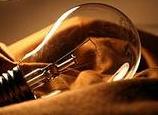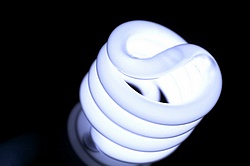|
Choosing the Right Bulbs
Choosing the right bulbs (lamps) can make a big difference in the function of a light fixture. Below we will take a look at the different types of bulbs available and the pros and cons associated with each different type. Incandescent Lamps
Incandescent lamps (your typical household bulb) are the most common. Although they are readily available and quite inexpensive incandescent bulbs are the least efficient of all burning out quickly compared to halogen,fluorescent and LED types. This type of lamp is good for general lighting and illuminating large areas. They come in various wattage from 15 to 150 as well as three ways which offer three different levels of wattage within the same bulb. The lower the wattage, the lower the light output. Incandescent lamps emit a yellow-white light producing a soft glow. Along with clear, they are available in frosted and multiple colors. Care should be taken not to exceed the recommended wattage for the particular fixture it is being used for. Halogen Lamps
Halogen lamps are more costly than incandescent but do typically have a much longer life span. They are smaller in size and have a much more intense light making them good for task lighting. They also come closer to matching the actual spectrum produced by the sun. Caution should be taken when changing halogen lamps as they burn much hotter than others. They also require special handling when putting in a new one as the oils from human skin can significantly shorten the life of a halogen lamp. The oil residue left on the lamp makes it burn hotter and thereby shortens the life.
Fluorscent (Standard & Compact)Fluorescent lamps are very energy efficient. They can last 10 to 20 times longer than incandescents. Although much costlier, they pay for themselves in the long run by saving on energy. They can use up to 20 to 40% less energy than incandescents. Compact Fluorescents (CFL) can replace nearly every incandescent bulb in the house providing an energy efficient alternative to the standard incandescents. They are available in warm white, cool white and daylight. Although fluorescents have not been know for the quality of lighting, great strides have been made to produce lamps that offer warmer and softer lighting. Most state and local codes require fluorescents to be used in closets where clothing is stored. They also make good task lighting such as under wall cabinets in a kitchen.
Proper IlluminationConsidering the proper illumination of a room for General Lighting is easily calculated by using the following formula.
So for example if a room were 10 feet by 12 feet the square footage would be 10 x 12 = 120 s.f. The 120 square feet is then multiplied times 1.5; 120 x 1.5 = 180 watts. Any combination of light fixtures totaling 180 watts should properly illuminate a space for general lighting. For task lighting, the same formula is used except the multiplier for the wattage is changed from 1.5 to 2.5 So for calculating the proper wattage for a work desk that is 3 feet wide by 5 feet long the square footage would be 3 x 5 = 15 s.f. The 15 square feet is then multiplied by 2.5; 15 x 2.5 = 37.5 watts. So a minimum of a 40 watt bulb would be required to properly illuminate the work surface. The lighting of your home can be as subtle or as dramatic as you would like it to be but choosing the right bulb and amount of light is critical to the success of any lighting plan. Using the tips and calculations above will give you a good start on creating interest and dimension to each room of your home.
Unknown Danger
Although CFLs can save hundreds of dollars over the course of the bulbs life, they also have a dangerous side to them. Do you know what to do with one if it breaks or burns out? Although there are warnings on the packaging, it is doubtful that most people have read them. Compact Fluorescent Lamps contain approximately 5 milliliters mercury. This may not sound like a lot, but they are considered “hazardous household waste”. They should not be discarded in standard trash or in an incinerator unless approved by your city or municipality. In the event that you are allowed to dispose of with your normal trash collection, it is safe to assume that there would still be regulations in place such as putting it in a double sealed plastic bag. If you should break a CFL, caution should be taken to clean it up. You should NEVER vacuum or sweep up the broken particles as this will spread mercury through the air you breathe. The large pieces can be handled by picking them up with a piece of cardboard, smaller ones with a piece of sticky tape. You should put the particles, cardboard and tape into a sealed jar or plastic bag before disposing. You can find additional information on disposal and handling of CFLs at the government's Energy Star website.
Return from Bulbs to Electrical Planning
|
